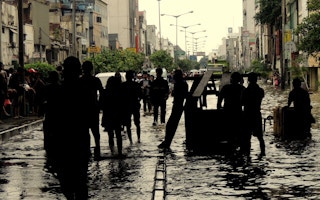Cities, even those sited away from coastal areas, can benefit from nature-based solutions such as the restoration of mangroves and coral reefs to combat rising sea levels and global warming.
To continue reading, subscribe to Eco‑Business.
There's something for everyone. We offer a range of subscription plans.
- Access our stories and receive our Insights Weekly newsletter with the free EB Member plan.
- Unlock unlimited access to our content and archive with EB Circle.
- Publish your content with EB Premium.
But what measures should communities roll out for the best outcomes and greatest return on investment?
As the man tasked to set up the new Centre for Nature-based Climate Solutions at the National University of Singapore (NUS), these are some of the questions that conservation scientist Koh Lian Pin aims to help governments and corporate leaders in the Asia Pacific address. The centre is expected to be operational by the end of this year.

Image: Koh Lian Pin
Research on nature-based climate solutions is complex because of different and competing priorities in society, said Koh, who was appointed Professor of Conservation Science, Technology and Policy at NUS’ department of biological sciences this month.
“For example, reforestation is a promising strategy for climate mitigation as it essentially converts carbon-dioxide in the atmosphere into plant material in the form of trees and other vegetation. However, doing so without due consideration of the other priorities of society may lead to unintended and negative impacts on people’s livelihoods or compromises to their food security,” he said.
Before returning to Singapore after more than a decade abroad, Koh held roles at the University of Adelaide in Australia and the non-profit Conservation International Foundation, where he was vice-president of science partnerships and innovation.
He is also founding director of the non-profit ConservationDrones.org, which seeks to introduce drone technology to conservation practitioners worldwide.
Developments, both exciting and worrying, are afoot in the region.
Singapore plans to spend S$100 billion (US$72 billion) or more on climate change defences, including nature-based solutions, over the next 50 to 100 years. The Philippines could host Asia Pacific’s first blue carbon project that uses a ground-breaking method to calculate the amount of carbon stored in mangroves.
But their Southeast Asian neighbour, Myanmar, is a hotspot for mangrove deforestation and the storm surge-reducing ecosystems are being lost to rice farming and other human activity.
Urban migration continues in the Asia Pacific and its megacities—already challenged by issues such as flooding and sinking—continue to grow.
Koh shared with Eco-Business how nature-based solutions can improve quality of life for city dwellers and the role businesses can play.
Protection and restoration of mangroves, coral reefs, and forests are mentioned most often when we talk about nature-based climate solutions. Are these also the most relevant or applicable solutions to Asia’s urban centres?
Nature-based climate solutions are relevant even to cities located far from forests, mangroves or coral reefs.
City dwellers can influence production practices in distant lands through the choice of goods they consume. For example, when we choose to import and consume more sustainably produced foods, we indirectly contribute to climate mitigation by incentivising the better management of agricultural lands, the protection of natural ecosystems and the rehabilitation of coastal habitats, which are all key aspects of nature-based climate solutions.
While nature-based climate solutions include improved management practices in agriculture, forestry and pasturelands, the most impactful nature-based solutions for climate mitigation in Southeast Asia and the world are reforestation and avoiding further deforestation.
Southeast Asia’s major cities like Bangkok, Jakarta and Manila are often associated with flooding, land subsidence, severe air pollution, traffic congestion and slums. How can nature-based solutions help?
To be sure, nature-based solutions are not a panacea for all our environmental woes.
But there is strong evidence to suggest that environmental well-being has direct impact on human well-being. For example, the loss of mangroves, seagrass and other coastal habitats has been linked to a higher incidence and severity of flooding events in adjacent villages and cities. The draining and burning of peat swamp forests for agriculture has severe consequences for the health of city dwellers many hundreds of kilometres away.
These direct and indirect human costs of environmental degradation must be taken into account in urban planning.
Conversely, the protection and better management of natural ecosystems have significant economic values that must be adequately taken into account in the financial balance sheets of governments and corporations.
How would you get urban authorities and residents to care more about nature-based solutions?
I believe that most urban planners and authorities do understand the need to consider nature in their land use decisions and policies. We can help by continuing to communicate the many benefits of nature-based solutions for the climate, environment and human well-being.
For example, the planting of more trees and vegetation within cities, in general, can help remove carbon-dioxide from the atmosphere for climate mitigation, act as natural buffers against flash floods, and provide green spaces for office workers to unwind and de-stress.
What role can businesses play in implementing or promoting nature-based solutions?
Traditionally, businesses have been supporting forest protection and reforestation projects as part of their corporate social responsibility goals or sustainability compliance requirements.
More recently, however, businesses are beginning to see carbon finance projects, including nature-based climate solutions, as new investment opportunities with potentially significant return on investment.
I think for nature-based solutions to be implemented at scale… we need research institutions to produce the science and technology, the corporate sector to fund the enterprise, and the public sector to create enabling conditions and policies.
How do we decide between nature-based solutions and “hard” climate protection measures such as sea walls and surge barriers?
Human-engineered and nature-based climate solutions are equally important sets of options for climate mitigation and adaptation. I think decisions boil down to a proper accounting of the cost effectiveness of any solution given the geographical, technical and socioeconomic contexts.
In fact, Singapore has been implementing them in tandem as green-grey infrastructure (natural features and built structures), for example, through the complementary use of both concrete canals and bioswales to direct water flow and mitigate the impacts of storm waters in our city.










